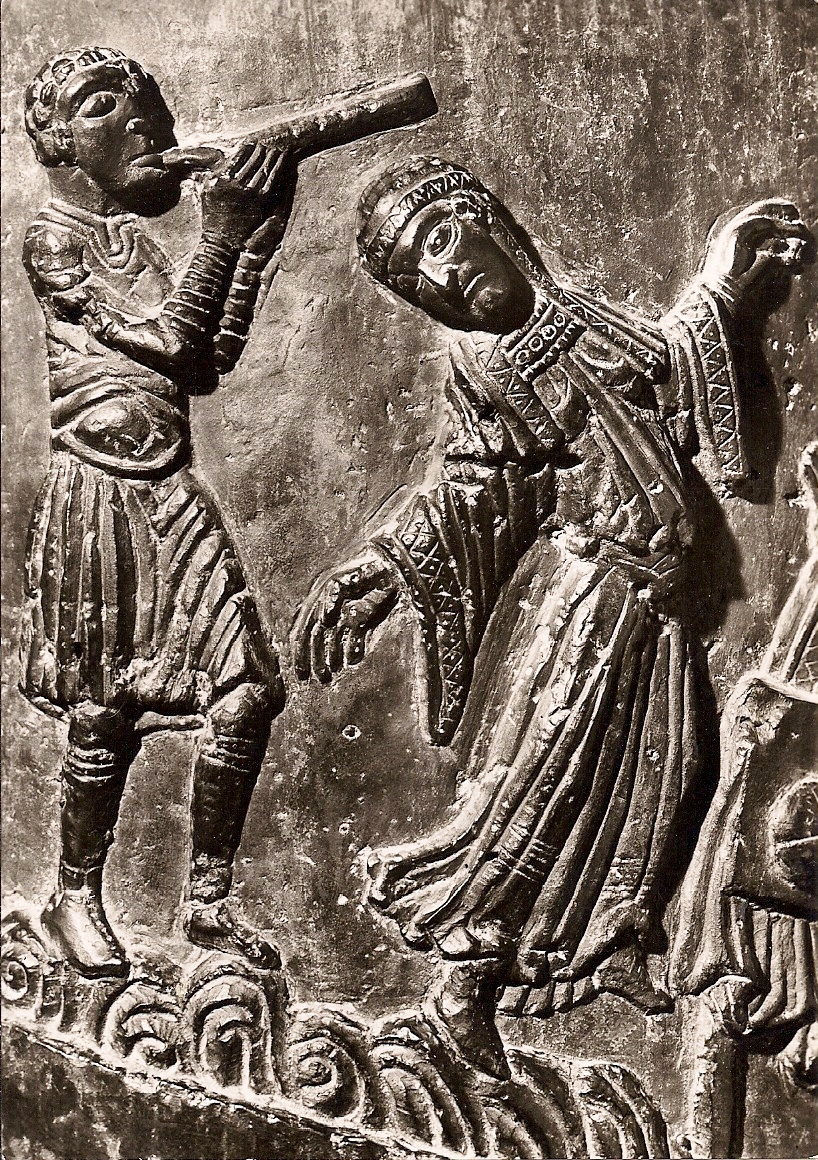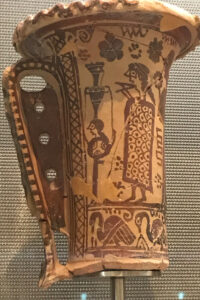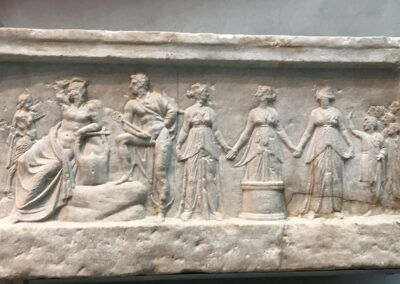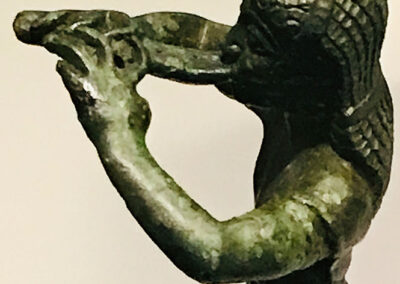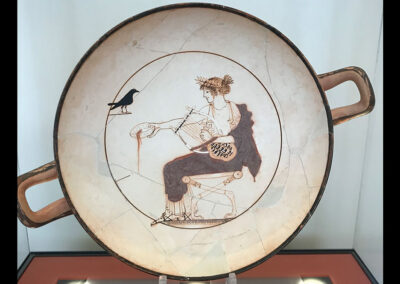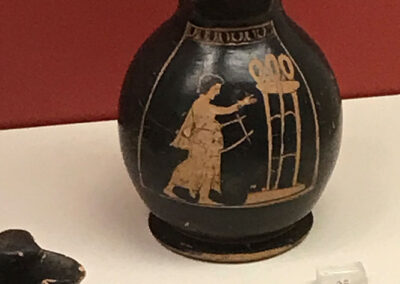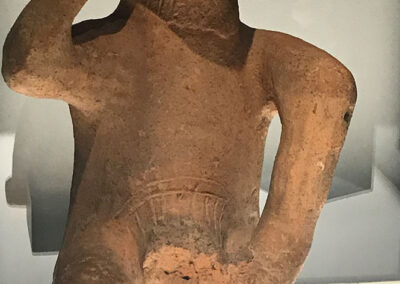Der Tanz der Salome
Die Szene mit dem Tanz der Salome, der Tochter der Herodias, die sich mit ausgreifenden Gesten zur Musik des Flötenspielers links von ihr bewegt. Wie die Perikopen anführen, wünscht sich Salome als Lohn für diesen Flöttentanz, den Kopf Johannes des Täufers.
(siehe Foto);
Ausschnitt Christussäule, (Bernwardssäule) im Hildesheimer Dom ist eines der Kunstwerke aus der Zeit Bischof Bernwards(993–1022), deren herausragende Bedeutung ihr zusammen mit der ebenfalls im Dom befindlichen Bernwardstür und der Bilderdecke in St. Michaell die Einstufung als Weltkulturerbe eingetragen hat.
Die Legende selbst erscheint im Neuen Testament folgendermaßen: Herodias begehrte den Tod des Johannes, doch Herodes weigerte sich, diesen töten zu lassen. Anlässlich einer Geburtstagsfeier des Herodes, der viele Würdenträger beiwohnten, führte die Tochter der Herodias einen Tanz auf, mit dem sie die Anwesenden derart in Verzücken versetzte, dass Herodes ihr schwor: „Um was du mich auch bitten wirst, ich werde es dir geben bis zur Hälfte meines Reiches“ (Mk 6,23 EU). Das Mädchen fragte ihre Mutter, was sie sich wünschen solle, und diese flüsterte ihr das eigene Begehren ein. Sie solle den Kopf des Johannes verlangen. Diesem Wunsch konnte sich Herodes Antipas „um der Eide und um derer willen, die mit zu Tisch lagen“ nicht verweigern. Er ließ Johannes köpfen und das Haupt auf einer Schale der Tänzerin bringen.(Quelle wikipedia.org)
International Society for Clinical Neuromusicology (CNM)
uia.org/s/or/en/1122276154
History: Founded 2008 by Klaus von Wild and Micheal Thaut in cooperation Eckart Altenmueller in Hanover, also referred to as Clinical Neuromusicology (CNM). Registered in accordance with German law. Aims: Further and initiate all activities that support, advance, develop comprehensive knowledge, interdisciplinary exchange regarding the neuroscientific foundations of music perception and production as well as the role of music in clinical neurology for disorders of the human nervous system.
Music and Mind
The Impact of Music on Emotions and Human Skills and Wellbeing
In Honor of Giorgio A. Brunelli
Author: von Wild, Klaus Ruediger H.
Source: American Journal of Neuroprotection and Neuroregeneration, Volume 8, Number 1, October 2016, pp. 27-36(10),
Publisher: American Scientific Publishers, DOI: doi.org/10.1166/ajnn.2016.1121
Abstract: Music in mysteries and medicine are known for their very old tradition because of its impact on emotions, human skills, and social life. Archeology, Paleo-Anthropology, Ethnology, Neuroscience, and Neuro-musicology give us some answers, when and why music became part of human mind and social life. New imaging techniques show specific areas within the human brain when they are activated by music. Mental-cognitive, sensorimotor, and subcortical regions can be watched during when listening, performing, imaging, and experience special forms of music. So we learned about the influence of the time spent and the necessity of a regular certain intensity when practicing music in childhood so that the plasticity of nerve cells will be enhanced and kept for the rest of life. Brain research on music has taken off in the past 50 years. Neuro-musicology helps us to better understand and to learn more about music and the mind. Recently new insight and good evidence allowed us to introduce music therapy as an adjunct treatment modality into neurorehabilitation, when specially designed programs support emotionally physical and neurobehavioral skills for restoration of central nervous lesions and to enhance health related quality of life. Music has shown to positively alter attention and perception of the external world and self by releasing dopamine and other neurotransmitters that help to fix the individuals awareness as well as control of sensorimotor activities. We learned how body and mind are touched by rhythm, tone, melody, and timber. In 2007 at the annual congress of the World Academy for Multidisciplinary Neurotraumatology (AMN) the author invited international neuroscientists, doctors, neuropsychologists, musicians, educators, neurorehabilitation specialists, and physical therapists for establishing the International Society for Clinical Neuromusicology (CNM), dedicated to advance multidisciplinary research and clinical studies on music and mind in rehabilitation medicine when focusing on the restoration physical and mental-cognitive functions following brain and spinal cord lesions.
Neuromusicology – Faszination von Music and Mind
sanctuary of the Nymphs and Pan. Dedication
Apollo with a Kithara, Hermes with a kerykeion and three Nymphs dance around an altar. At left Pan plays the syrinx(flute with several holes):at right group of worshippers.
Flute-Player figurine
He plays double flute and wears a long sleeved, light tunic(chiton).Corinthian workshop 550-525 BC.
https://en.wikipedia.org/wiki/Asklepieion_of_Athens
The Asklepieion of Athens was the sanctuary built in honour of the gods Asclepius and Hygieia, located west of the Theatre of Dionysos and east of the Pelargikon wall on the southern escarpment of the Acropolis hill.
